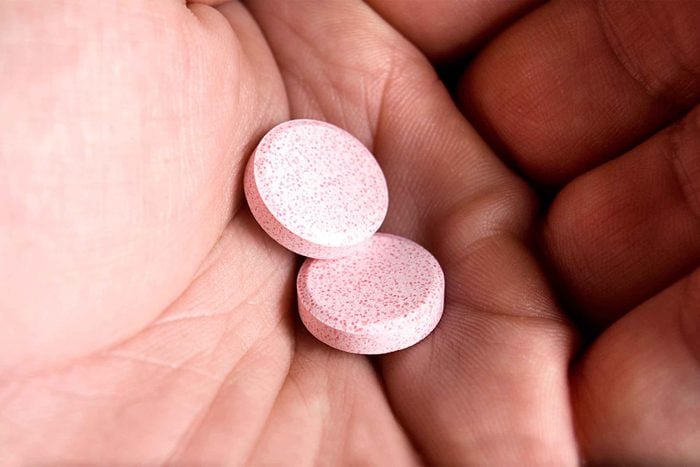This is what happens when you don’t eat the right kinds of fat
Too much of certain kinds of fat—saturated fat (mostly foods with animal fat) and trans fat (mostly foods with hydrogenated vegetable oils)—can lead to an increased risk of heart disease. These fats can raise total cholesterol levels in the blood and trans fats can increase the amount of “bad” low-density lipid (LDL) cholesterol and decrease the amount of “good” high-density lipid (HDL) cholesterol in the blood.
Instead, experts recommend that you try to eat more healthy fats, like monounsaturated fats (MUFAs) and polyunsaturated fats (PUFAs), which can be found in fatty fish, olive oil, nuts, and more. (Here are some heart-healthy foods that help lower cholesterol.)
In the United States, the Food and Drug Administration (FDA) announced trans fats are no longer safe foods to eat due to the high risk of elevated cholesterol and heart disease. On June 18, 2018, the official ban of trans fats went into effect. However, the agency extended the compliance date to January 1, 2020, and in some instances up to January 2021.
This means that you’re much less likely to encounter products with trans fat, although the FDA does allow foods that contain less than 0.5 grams of trans fats per serving to be labeled as having “0 grams” of trans fat.
So, what’s the best way to monitor whether you’re consuming too much of certain types of fat in your diet? Pay attention to the following signs.

You keep having memory problems
If you struggle to remember names, dates, or what you ate for breakfast this morning, it can be due to many different factors—and should be investigated by your doctor if it’s an ongoing problem. That said, you might want to take a look at your diet.
A 2012 study published in Annals of Neurology analyzed the diets of more than 6,000 women over the age of 65 and found that those who consumed the highest amount of saturated fat had worse overall memory and cognition over four years of testing. Swap out saturated fat-heavy butter and red meat for olive oil and fish rich in mono- and polyunsaturated fats, which are thought to help protect against mental decline. (These are signs you need to eat more good fats.)

You don’t read nutrition labels
“People might be eating a lot of trans fat without even realizing it, depending on which processed foods they buy,” says Georgia Giannopoulos, RD-AP, a board-certified specialist in obesity and weight management in New York City. Trans fat is often listed on the ingredient list as “partially hydrogenated oil.” It has been linked to a greater risk of heart disease, stroke, and type 2 diabetes.

You think all food fats are equal
“Not knowing what types of fats are healthier than others is a big reason people might eat too much of the bad,” says Giannopoulos. Saturated fat is found in red meat, whole milk, cheese, butter, and poultry with the skin on. It’s also found in some oils that people mistake for super-healthy, such as coconut. “Olive oil, sunflower oil, and flaxseed oil are better for you,” she says. (Check out the high-fat foods that are actually super healthy.)

You take antacids after eating too much fat
If you take your morning coffee with a side of Tums, it could be a sign you’re eating too much fat. Saturated fat takes longer to digest, so when you eat a fatty meal, indigestion, and heartburn can bubble up the next day when excess stomach acid splashes back into your esophagus. (Here are natural remedies for heartburn relief.)

You’re constantly eating fried foods
French fries and chicken wings might be treats for your tastebuds, but not for the rest of your body. Deep fried foods may contain trans fat, which can throw your good and bad cholesterol levels out of whack and may even increase your insulin resistance, which is linked to type 2 diabetes risk.

You have high cholesterol
If your cholesterol levels are higher than your doctor would like, don’t assume only your genetics are to blame. Saturated fat drives up levels of bad cholesterol in your blood, which can increase your chance of developing heart disease. If your cholesterol is high, be mindful of how much red meat, eggs, and fatty dairy you consume; and follow the American Heart Association’s recommendation of no more than 11 to 13 grams of saturated fat a day for a 2,000 calorie diet. (These are the worst eating habits for cholesterol.)

You cook everything in butter
If you try to mimic your favorite TV chef in your own kitchen, you’ll likely find butter makes a frequent appearance. But beware—just one tablespoon of butter contains 12 grams of fat, almost all of it saturated fat. While some butter advocates say that’s fine, most groups like the American Heart Association still recommend limiting saturated fat. Leave the butter for your toast and use olive oil, which is filled with healthy monounsaturated fat, for cooking. (Also, find out what movie theatre butter is made of.)

You’re gaining more weight
A small 2014 Swedish study in the Journal of the American Heart Association found that participants who ate a large amount of saturated fat (in the form of muffins) over the course of seven weeks gained more belly fat than those who ate muffins made with polyunsaturated fat. (Here’s how to lose belly fat without exercise.)
